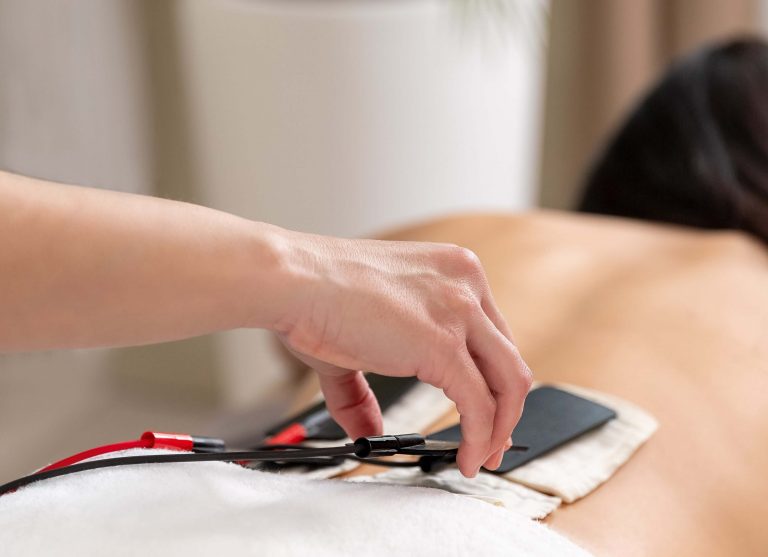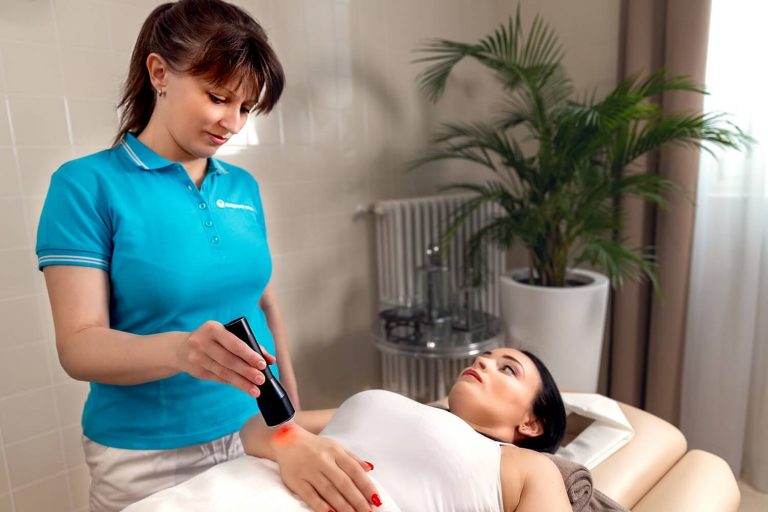Contact us with confidence!
Facebook-f
Instagram
Linkedin-in
Youtube
So-called physical therapy treatments are in fact physiotherapy procedures that utilise the physical energies found in nature to treat the body. These are natural energies that are produced in an artificial fashion nowadays in modern medicine. It is a fundamental fact that only energy that is actually absorbed by the body can exert an effect. Physical therapy is known to have both local and general effects, and is used for preventive purposes (to prevent the development of certain symptoms and diseases) or to alleviate musculoskeletal, nervous and circulatory problems.
The pain-killer and local anti-inflammatory effects of the various physical therapy procedures can influence a person’s condition in an extremely favourable way. The various procedures improve the blood supply to the tissues, which results in a positive influence on the metabolic processes of the cells. Certain physical therapy procedures show a beneficial effect in relation to spasms caused by increased muscle tone, as well as reduced range of motion of the joints or decreased nerve excitability.
The treatments are administered during a treatment course, which usually consists of 10 sessions for each treatment type to achieve the desired effect. Specialist rheumatologists recommend physical therapy treatments to treat various symptoms taking into account the individual’s medical history and complaints. These therapies are most often utilised in combination to increase their effectiveness.


Magnetic therapy uses the beneficial effects of this special space, such as vasodilatation, improvement of tissue microcirculation, lymphatic circulation, stimulation of the immune system. The treatment heads can be rings, pillows or mats.
Bemer therapy is a special magnetic therapy method in which the treatment head is always a mat. It has an excellent effect on cell regeneration, stimulates the immune system and improves microcirculation.
The oldest electrotherapeutic treatment. By adjusting the direction of the current and the placement of the electrodes, different effects can be achieved with the therapy. This form of current is often used to deliver the active ingredients of medications and ointments. This procedure is called iontophoresis.
A special galvanic treatment performed with a special electrode. Treatment specifically for sciatic nerve or arm nerve pain. The interesting thing about the electrode is that it reaches the entire length of the limb, whether at the lower or upper end.
In this procedure, a drug solution is injected into the body, and electrodes are placed to surround the affected area. Solutions are broken down into ions by electric current so that flow can be induced if the electrodes are placed correctly.
This form of current uses a combination of galvanic current and excitation current. By varying the form of the excitation current, we can achieve different sensations and effects in the body. The patient may feel a rippling, pulsating or even vibrating current. The effect can be analgesic, normalise muscle tone or stimulate the absorption of edema.
Electrical stimulation for the treatment of paralysis of peripheral nerves or atrophied muscles with intact innervation. During treatment, contraction of the treated muscle or nerve is expected so that we can work and help the affected muscle heal. In the lower limbs, it is most commonly used to stimulate the leg muscles, quadriceps, and hamstrings, but it is also used for facial nerve palsies. For peripheral nerve palsies, it is important to start treatment as soon as possible, as the chances of nerve regeneration decrease with time since injury.
The name of this treatment comes from the fact that the circuits cross and reinforce each other’s effects, superimposing each other, so to speak. Analgesic, muscle relaxant and vasodilator treatment.
The name comes from an acronym (transcutaneous electro-neuro-stimulation), i.e., electrical stimulation through the skin. It is mainly a pain-relieving treatment.
The name laser comes from an English acronym. To produce the light, an electric current is needed, but the treatment is actually phototherapy, that is, the light has the therapeutic effect. Its therapeutic significance is that it can be used in acute cases and the presence of metal implants or pacemakers is not a contraindication.
Ultrasound is a sound wave that exerts physical, biological and chemical effects on the treated body part. It is widely used in medicine to relieve pain caused by degenerative lesions and to soften tissues. In order for this wave to penetrate the tissue, an ultrasound gel is always applied to the area to be treated. For treatment of the hand or foot, water should be chosen as the medium because of the anatomical conditions.
Ultrasound is usually classified under mechanotherapeutic treatments and described in detail there.
Please fill out the form below and our staff will contact you.

Address:1146 Budapest, Állatkerti körút 9-11.
E-mail:szechenyi.medical@budapestspas.hu
Phone:+36 30 757 6110
All rights reserved. 2023 Széchenyi Gyógyfürdő és Uszoda – Legal declaration – Data protection – General Terms and Conditions
This website uses cookies so that we can provide you with the best user experience possible. Cookie information is stored in your browser and performs functions such as recognising you when you return to our website and helping our team to understand which sections of the website you find most interesting and useful.
Strictly Necessary Cookie should be enabled at all times so that we can save your preferences for cookie settings.
If you disable this cookie, we will not be able to save your preferences. This means that every time you visit this website you will need to enable or disable cookies again.